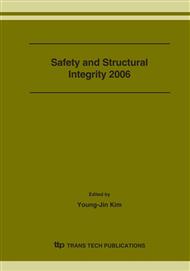p.119
p.129
p.135
p.141
p.147
p.157
p.163
p.169
p.175
Finite Element Alternating Method for Interacting Surface Cracks
Abstract:
The finite element alternating method (FEAM), in conjunction with the finite element analysis (FEA) and the analytical solution for an elliptical crack in an infinite solid subject to arbitrary crack-face traction, can derive the stress intensity factor (SIF) of surface cracks by using the FEA results for an uncracked body. In the present study, the FEAM was applied to evaluations of SIF for noncoplanar multiple surface cracks. The SIF was evaluated for two surface cracks of dissimilar size, and three crack of the same size. The results suggested that the interaction is greatly affected by the relative crack size and negligible when the difference in the crack size is large enough, and the interaction can be evaluated by taking into account the adjacent cracks even if there are many cracks around them. Finally, the crack growth simulations were conducted and a possibility of the direct evaluation of influence of interaction between adjacent crack without using the combination rules was revealed.
Info:
Periodical:
Pages:
147-153
Citation:
Online since:
February 2007
Authors:
Price:
Сopyright:
© 2007 Trans Tech Publications Ltd. All Rights Reserved
Share:
Citation:


